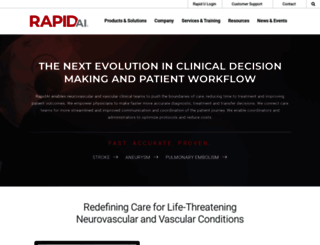Aneurysm, pulmonary embolism and stroke software platform powered by AI
Page Load Speed
2.1 sec in total
First Response
102 ms
Resources Loaded
1.3 sec
Page Rendered
633 ms

About Website
Click here to check amazing Rapid content. Otherwise, check out these important facts you probably never knew about rapid.ai
RapidAI enables neurovascular and vascular clinical teams to push the boundaries of care, reducing time to treatment and improving patient outcomes.
Visit rapid.aiKey Findings
We analyzed Rapid.ai page load time and found that the first response time was 102 ms and then it took 2 sec to load all DOM resources and completely render a web page. This is quite a good result, as only 40% of websites can load faster.